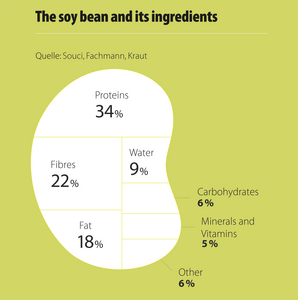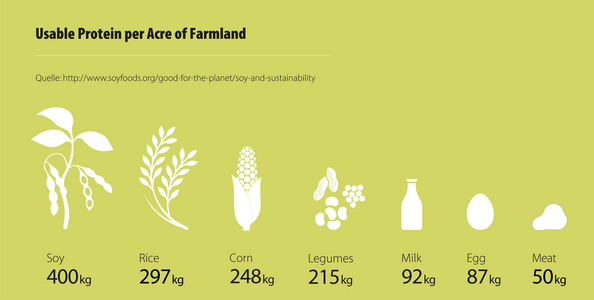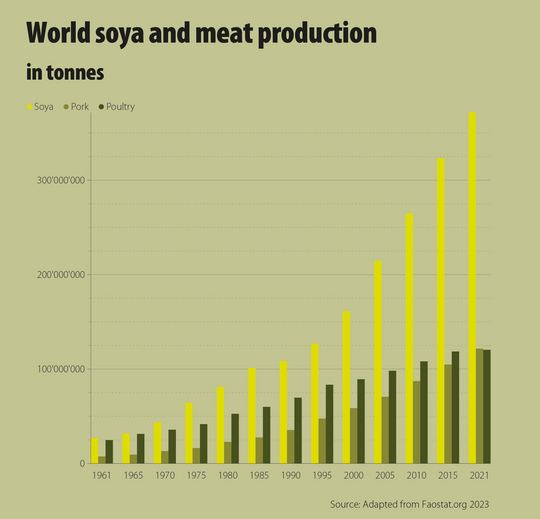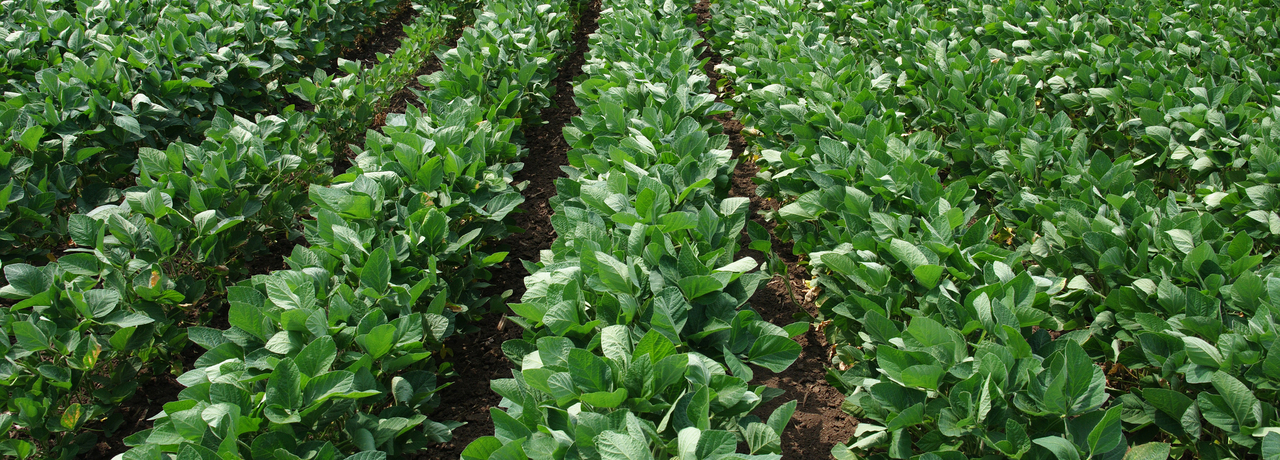Miracle plant
Soya is one of the most ecologically valuable and efficient crops in the world. The soya plant can cover around two thirds of its nitrogen requirements itself, which is why it requires little fertiliser. The favourable production costs and the high protein values as well as the protein composition (the amino acids are comparable to animal protein) predestine it for a wide and versatile use. In the form of lecithin, flour, tofu or oil, soya is an important part of our diet. However, soya is also used in animal feed, cosmetics, printing inks, plastics and agricultural fuels.
Around 75% of the soya produced worldwide is used as animal feed, especially for pigs and poultry. Soya is very digestible for livestock. If we wanted to cover our protein requirements with another plant, we would have to cultivate larger areas.


Boom with consequences
Although soya is an important source of protein for humans and animals and a crucial source of income and foreign currency for the countries where it is grown, the legume also brings with it negative developments. The environmental problems caused by intensive cultivation and the expansion of agricultural land range from water pollution to soil erosion and declining biodiversity. Changes in land use and the production and use of fertilisers for soybean cultivation result in high greenhouse gas emissions. The expansion of soya cultivation also leads to social conflicts and tensions between producers and the respective communities due to land and labour rights, rural exodus, etc.
Thanks to the soya moratorium, deforestation in the Amazon is declining. Wholesalers are now avoiding soya from areas in the Brazilian Amazon that were deforested after July 2006. However, the pressure on the Brazilian Cerrado (wet savannah area) with its exceptionally high biodiversity remains high. Since the end of 1950, around half of the Cerrado has been converted into agricultural land.

Production and trade
Soya is one of the world's most traded commodities and is produced on around 9.5% of global arable land. In the last 40 years, demand and production of soya have increased fivefold. The main reasons for this development are the pent-up demand for animal proteins in Asia and the shift towards greater consumption of low-fat poultry meat in Western countries.
According to FAOSTAT, 350 million tonnes of soybeans were produced on 133 million hectares of land worldwide in 2022. The USDA expects almost 400 million tonnes of soybeans produced in 2023. The USA, Brazil and Argentina are responsible for 80% of total production. The largest producing countries are also the largest exporters of soya. The largest importing country is China. Until 1990, China imported almost no soya. Today, the country imports around three times the amount consumed in the EU (approx. 100 million tonnes).
GMO-free soya for Switzerland increasingly from Europe
While Switzerland has always completely avoided the cultivation and import of genetically modified soya, the global cultivation of genetically modified (GMO) soya is increasing. It is estimated that almost 80% of the soya cultivated worldwide is genetically modified (WWF Germany, 2023). In 2019, 94%, 97% and 100% GMO soya was grown in the three largest producing countries, the USA, Brazil and Argentina respectively. GMO-free soya imported into Switzerland is therefore increasingly coming from Europe.
In Switzerland, genetically modified feed must be declared in accordance with the 1999 Feed Regulation. The various label programmes in Switzerland (IP-Suisse, Naturafarm, Bio Suisse/Knospe, Suisse Garantie, QM Schweizer Fleisch, Mutterkuh, and others) require feeding without genetically modified feed. Accordingly, all imported soya products must come from GMO-free cultivation. Unintentional mixtures with GMOs are permitted under Swiss legislation, provided they do not exceed the defined limits of max. 0.9% contamination for authorised GMOs.
Protein requirements in Switzerland
In Switzerland, 78% of livestock feed is based on domestic grass, hay, cereal and 22% on concentrated feed. Switzerland covers 15% of its crude protein requirements itself. Around 4'000 tonnes of soya are produced on 3'300 hectares in Switzerland. About half of this is used as animal feed. There is a lack of breeding, yield stability and climatic and topographical conditions to substantially expand the production of protein animal feed.
Swiss importers have steadily reduced their dependence on Brazil in recent years. Today, they source feed soya primarily from Europe, including Germany, Italy, Austria and Ukraine. This reduces dependence on one country of production. This has enabled Switzerland to increase the proportion of soya from Europe to over 95%. Read more about Switzerland's sustainable protein supply in our position paper.


